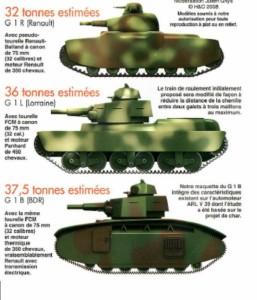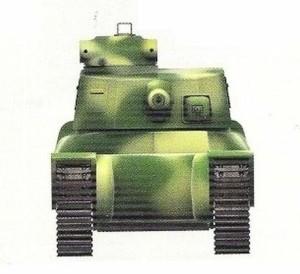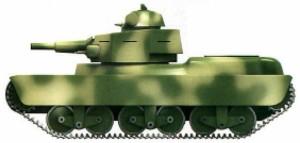In the thirties, the French army made a project called “Char Moyen d’Infanterie de 20 tons.” The point was to create a 20ton tank for support infantry armed of 75 mm howitzer in the front, a 47 mm in a rotating turret and at least a machine gun. Seven large French companies, including the Lorraine de Dietrich, responded to the needs with at least one project. Lorraine engineers decided to remove the 75 mm howitzer from the hull and install an APX4 turret armed only with a 47 mm gun. The planned engine was a Hispano-Suiza of 230 hp.The length was to be 550 cm, and the width was to be 250 cm.
In the summer of 1938 a mock-up was ready. However, the specifications for the 20ton tank changed in 1939. Then the design of the Char G1L was changed to fit a 75 mm gun turret and the weight increased to 36 tonnes. To compensate for the greater weight, a more powerful Panhard engine of 450 hp was planned; however the engine deck had to be raised to accommodate this more powerful engine, impeding a full rotation of the heavier FCM turret. These changes increased the tank height to 290 cm and overloaded the suspension. In early 1939, Lorraine tried to create a turret derived from the ARL 3 type, but not a single ARL 3 turret had yet be constructed, even as a mock-up. This Lorraine turret was somewhat lower, helping with the overall height; however, the new turret’s decreased height resulted in a limited depression of the gun. On 13 April 1939, the commission recommended that the G1L project be abandoned, but this was refused by the ministry of defence. On 10 September, after the outbreak of war, it was finally suspended.
Source –
- Stéphane Ferrard, 2007, “Le Futur Char G1, 1re partie 1935-1938: Le Char de 20 Tonnes”, Histoire de Guerre, Blindés & Matériel, N° 78, pp. 38–47
- Stéphane Ferrard, 2007, “Le Futur Char G1, 1re partie 1935-1938 (2): La <<Bombe>> Renault et les autres 20 T”, Histoire de Guerre, Blindés & Matériel, N° 79, pp. 62–71
- Stéphane Ferrard, 2008, “Le Futur Char G1, 2e partie 1938-1940 (1): 35 tonnes maximum pour un 75 en tourelle”, Histoire de Guerre, Blindés & Matériel, N° 81, pp. 48–55
- Stéphane Ferrard, 2008, “Le Futur Char G1, 2e partie 1938-1940 (2): Vers le Char de 35 tonnes de Série”, Histoire de Guerre, Blindés & Matériel, N° 83, pp. 72–80
Negli anni Trenta, l’esercito francese realizzò un progetto denominato ” Char Moyen d’Infanterie de 20 tonnellate “. Il punto era di creare un carro per supporto fanteria da 20 tonnellate armato di obice da 75 millimetri nella parte frontale e un 47 mm in torretta rotante e almeno una mitragliatrice. Sette grandi società francesi, tra i quali la Lorraine de Dietrich, risposero alle esigenze con almeno un progetto. Gli ingegneri della Lorraine decisero di ed eliminare l’obice da 75 millimetri sullo scafo e di installare la torretta armata solo di un cannone da 47 mm
Nell’estate del 1938 un mock-up era pronto. Tuttavia, le specifiche peril carro da 20ton erano cambiate nel 1939. Quindi il progetto del Char G1L venne modificato per adattarsi ad una torretta con 75 mm e il peso aumentò a 36 tonnellate. Per compensare il maggior peso, venne progettato un motore più potente, un Panhard di 450 CV; tuttavia il vano motore doveva essere sollevato per ospitare questo motore più potente, impedendo però una rotazione completa della torretta pesante FCM. Questi cambiamenti aumentarono l’altezza del carro a 290 cm e sovraccaricarono le sospensioni. Nei primi mesi del 1939, la Lorraine cercò di creare una torretta derivata dal tipo ARL 3, ma non una sola torretta di questo tipo venne costruita, anche come un semplice mock-up. Quest’ultima torretta era un po ‘più bassa, aiutando ad abbassare l’altezza totale; tuttavia, la diminuita l’altezza della nuova torretta provocò una limitata depressione del cannone. Il 13 aprile 1939, la Commissione raccomandò che il progetto G1L fosse abbandonato, ma questo venne rifiutato dal Ministero della Difesa. Il 10 settembre, dopo lo scoppio della guerra, venne finalmente sospeso.



